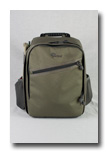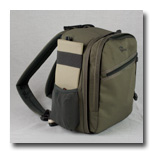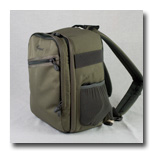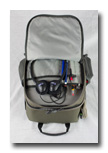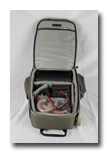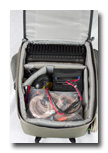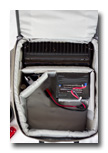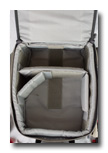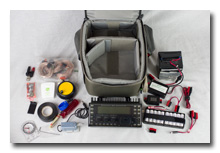by William Eric McFadden
The Enhanced KX3 Travel Kit is a small but complete low-power HF+6m station in a small, weather-resistant LowePro Traveler 150 photography backpack. The Enhanced KX3 Travel Kit is an enhancement of the original KX3 Travel Kit and is designed for rapid deployment following transport by foot or motorized transport.
The Enhanced KX3 Travel Kit is under continuous development. Photos may not represent the current state of the station. This page will change as various ideas are tested and accepted or rejected.
-
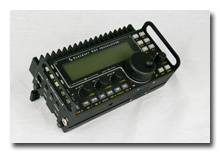 The heart of the Enhanced KX3 Travel Kit is an Elecraft KX3
low-power transceiver equipped with the KXAT3 Internal Automatic Antenna Tuner
module, the KXFL3 Dual-Passband Roofing Filter module, AK6Q Side KX Endplates,
and VE7FMN Cooler KX Lite heatsink.
The heart of the Enhanced KX3 Travel Kit is an Elecraft KX3
low-power transceiver equipped with the KXAT3 Internal Automatic Antenna Tuner
module, the KXFL3 Dual-Passband Roofing Filter module, AK6Q Side KX Endplates,
and VE7FMN Cooler KX Lite heatsink.
The trail-friendly KX3's all-band (160-6m) coverage, all-mode (CW/SSB/AM/FM/data) capability, competition-grade receiver, truly generous feature-mix, small size, low weight, and battery-friendly design make the KX3 an extraordinary field-radio.
-
The KX3 can operate over a voltage range of 8vdc to 15vdc. Internally, the KX3 can accomodate eight AA cells. A coaxial power socket is provided for connection to an external power source. When internal batteries are installed and external power is connected, the rig will use the source having the higher voltage.
Internal Batteries-
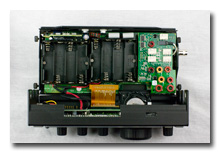 The KX3 internal battery holders accomodate eight AA cells. When
filled with 1.2v NiMH cells, this produces a nominal 9.6-volt battery-pack.
The KX3 internal battery holders accomodate eight AA cells. When
filled with 1.2v NiMH cells, this produces a nominal 9.6-volt battery-pack.
Because of reports from W8MHV of poor battery life when powering his KX3 with internal NiMH cells1, I have, at this point in time, decided against keeping NiMH cells in the KX3 or purchasing the KXBC3 Internal NiMH Charger / Real-Time Clock module.
-
For most operations with my KX3, I will rely on an external battery.
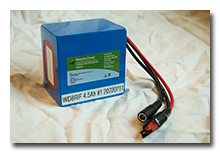 I currently carry a Bioenno (link) 4.5Ah LiFePO4
battery-pack to power my KX3. I can solar-charge this LiFePO4 battery while it's in use with a
pair of PowerFilm F15-300 5w foldable solar panels connected in parallel to a tiny,
no-longer-available, original Buddipole solar charge controller (link)
or a larger, more sophisticated, Bioenno solar charge controller (photo).
I currently carry a Bioenno (link) 4.5Ah LiFePO4
battery-pack to power my KX3. I can solar-charge this LiFePO4 battery while it's in use with a
pair of PowerFilm F15-300 5w foldable solar panels connected in parallel to a tiny,
no-longer-available, original Buddipole solar charge controller (link)
or a larger, more sophisticated, Bioenno solar charge controller (photo).
Before I acquired my Bioenno LiFePO4 battery packes, I carried a pair of rugged ten AA-cell holders (Batteries America p/n 10AAT, photo | link) I can fill with ten 1.2v NiMH cells or, in a pinch, eight alkaline cells (1.5v, 2.2 - 2.7Ah) or lithium primary cells (1.5v, 2.8 - 2.9Ah) plus two dummy cells. Either way they're configured, these packs are nominal 12-volt packs. I am currently using sets of ten Sanyo/Panasonic Eneloop 1900mAh NiMH cells with these battery-holder. (See KX1 Mini Travel Kit for a discussion on spring-type AA-cell holders.) I have found that these AA-packs will not allow me to drive my KX3 at an output power higher than 5 watts; the under-load voltage appears to be below a firmware-minumum for increasing power above 5 watts.
-
(The following paragraphs need to be re-written. In the meantime, see above.)
I have a pair of Powerfilm (link) FM15-300 5-watt foldable photovoltaic panels (photos: 1 | 2) which I use with a WB8VGE Micro-M charge controller (photo | link, ARRL Members Only) to charge the above-mentioned 2.2Ah or 5Ah gel-cell batteries. One of these panels plus the associated cables fit nicely in an outside pocket of the Traveler 150. (These FM15-300 panels are "blems/seconds" I purchased at a greatly discounted price directly from PowerFilm at the 2012 and 2014 Dayton Hamventions.)I also have a pair of glass-and-aluminum 5-watt photovoltaic panels. One of the panels is an inexpensive but relatively large (~ 12"x18") thin-film panel (photo) I purchased new at Harbor Freight. The second panel, an old Hoxan SP 5, is a polycrystalline panel (photo) and is much smaller (~ 9"x10"). I purchased this panel used at a hamfest but it still provides rated voltage and current. Either of these glass-and-aluminum panels would be the better choice for long-term operations or for operation when rain or severe weather is expected because Powerfilm recommends my foldable panels not be used while wet. (It is my understanding that newer Powerfilm foldable panels can be allowed to get wet.) Unfortunately, neither of the glass-and-aluminum panels can be carried within the Traveler 150.The Micro-M charge controller is configured to work with any of my photovoltaic panels and to allow me to charge a gel-cell battery while the battery is simultaneously powering the rig.
1 The KX3's power-output control doesn't directly set the transmitter output power. Rather, it tells the radio what power-output the operator wants and the radio makes sure that output-power is generated. Since P=IxE, lower supply voltage (E) means more current (I) must be drawn to produce a desired power (P).
-
-
The KX3 covers all bands 160m through 6m. It would be very challenging (or, more likely, impossible) to find a single easy-to-deploy field antenna that works well on all of these bands. Fortunately, I am primarily interested in operating on the bands 80m through 10m while in the field, making the task of finding a single field-deployable antenna that's small enough to pack easily much more manageable.
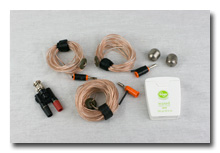 Currently, for 10m-80m, I carry a 28½' end-fed wire and three 17' counterpoise
wires which I hang as a vertical and connect to the KX3 through a homebrew 4:1 unun (links: 1 | 2)
or an Elecraft BL-1 4:1 balun. (I initially used a BNC-to-dual-banana-socket adapter
instead of an unun or a balun but there were some occasions during my National Parks
on the Air activations in 2016 when the KX3/KXAT3 wouldn't tune the antenna on one
band or another.)
Currently, for 10m-80m, I carry a 28½' end-fed wire and three 17' counterpoise
wires which I hang as a vertical and connect to the KX3 through a homebrew 4:1 unun (links: 1 | 2)
or an Elecraft BL-1 4:1 balun. (I initially used a BNC-to-dual-banana-socket adapter
instead of an unun or a balun but there were some occasions during my National Parks
on the Air activations in 2016 when the KX3/KXAT3 wouldn't tune the antenna on one
band or another.)
For better performance on 80m, I've tested a 58' (source) end-fed wire several times as a sloper, as an inverted-L, and as an inverted-vee. The first time, with the low-hanging 58' wire fed through a BNC-to-dual-banana-socket adapter, the KXAT3 tuned the antenna well on 80m only when the (then) 28' wire and two of the shorter wires were connected as a counterpoise. The second test, performed during a POTA activation of Dillon State Park (link), with the 58' wire sloping up to the top of a 33' fiberglass mast and fed through an Elecraft 4:1 balun, with a 28½' counterpoise wire lying directly under the sloper and a 17' counterpoise wire running in the opposite direction, the KXAT3 easily found good matches on all the bands tested: 20m, 30m, 40m, 60m, and 80m. Subsequent tests at POTA activations of Zaleski State Forest (link), Vinton Furnace State Forest (link), and Wayne National Forest (link) demonstrated that while the 58' wire sloper/inverted-L/inverted-vee through a 4:1 balun tunes easily on all bands of interest, the antenna doesn't operate as well on 20m and 40m as the 28½' end-fed wire vertical with three radials. QSOs were significantly harder to make at Wayne National Forest with the 58' wire than at nearby Burr Oak State Park (link) on the same afternoon with the 28½' wire vertical with three radials. (Note to self: N7RR reports that a 58' radiator with one 13.1' counterpoise loads on all bands 80m-6m on his KX3 with KXAT.)
For 10m-80m, I've tested a 42' W3EDP Jr. antenna (link). During my initial test, with the antenna connected through a 4:1 balun, my KXAT3 found a good match for all bands 10m-40m but didn't find a match on 80m.
To hang wire antennas in trees, I carry a length (~66') of very small parachute cord in a camping-style clothesline reel; I typically spool the line fully out of the reel, tie the free end to a half-full disposable water-bottle, and lob the bottle over a tree-branch or, if the tree is small, over the whole tree. I also carry a 100-yard spool of dental floss and a couple of large fishing weights to use in a similar fashion. Note to self: Consider painting the fishing weights highway-safety orange.
For my 2016 National Parks on the Air activations, I carried an MFJ-1910 33' fiberglass telescoping mast, a re-purposed roof-top tripod, stakes, and a hammer in a canvas military-surplus antenna-bag. I quickly found that erecting this mast assembly to support the 28½' end-fed wire is usually quicker and easier than throwing a line over a branch—and it works when there isn't a tree or branch available. This mast isn't tall enough to support the entire W3EDP Jr. as a vertical but can support it in an L, inverted-L or inverted-V configuration. I now also have a 31' Jackite fiberglass telescoping mast and a home-made drive-on support base for use when my station will be in or very near the car.
Descriptions of field-deployable antennas I've used with the larger K2 Travel Kit are located here. Any of the antennas that worked well with the K2 Travel Kit should work well with the smaller Enhanced KX3 Travel Kit but may need to be carried externally.
-
Electronic Keyer & Paddle
-
The KX3 has a perfectly adequate built-in memory keyer so I don't need to carry an external memory keyer with the Enhanced KX3 Travel Kit.
Having given up on dual-lever keyer paddles, I chose not to purchase the otherwise excellent Elecraft KXPD3 Precision Iambic Keyer Paddle for use with my KX3.
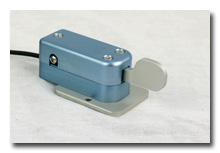 Initially, I used an American Morse Equipment (link)
Mini-B Miniature Single Lever Paddle (photos: 1 | 2)
when keying electronically in the field. I had developed a bracket to mount the Mini-B on
the KX3 transceiver (photos:
1 |
2 |
3 |
4).
Initial tests indicated this bracket works well. I had also purchased the AME Porta-Paddle
Leg Mount (link) for use
with the Mini-B but have not tried it in the field. The Leg Mount fits nicely in an
outside pocket of the Traveler 150.
Initially, I used an American Morse Equipment (link)
Mini-B Miniature Single Lever Paddle (photos: 1 | 2)
when keying electronically in the field. I had developed a bracket to mount the Mini-B on
the KX3 transceiver (photos:
1 |
2 |
3 |
4).
Initial tests indicated this bracket works well. I had also purchased the AME Porta-Paddle
Leg Mount (link) for use
with the Mini-B but have not tried it in the field. The Leg Mount fits nicely in an
outside pocket of the Traveler 150.
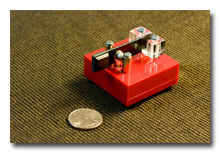 UPDATE: During the 2016 National Parks on the Air year-long event,
the Mini-B got intermittent, as if the contacts were dirty. Cleaning with DeOxit and
light burnishing restored performance for a while but the problem kept returning. I
finished the NPOTA year using my Whiterook MK-33 Mini Single Lever Paddle (photo | link)
and it has since become my go-to paddle for field operations. I usually use the MK-33 as
a cootie-key / sideswiper.
UPDATE: During the 2016 National Parks on the Air year-long event,
the Mini-B got intermittent, as if the contacts were dirty. Cleaning with DeOxit and
light burnishing restored performance for a while but the problem kept returning. I
finished the NPOTA year using my Whiterook MK-33 Mini Single Lever Paddle (photo | link)
and it has since become my go-to paddle for field operations. I usually use the MK-33 as
a cootie-key / sideswiper.
The Whiterook MK-33 has become my paddle of choice for field operations and I have one in each of my various field-kits.
-
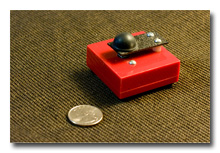 I've come to realize that when wearing gloves, as I almost certainly will be doing during
the annual "Freeze Your B___ Off" events, a straight key would allow me to send better CW
than would a small keyer paddle. In this situation, I will use my lightweight Whiterook
MK-22 Pocket Mini CW Key (photo | link).
I've come to realize that when wearing gloves, as I almost certainly will be doing during
the annual "Freeze Your B___ Off" events, a straight key would allow me to send better CW
than would a small keyer paddle. In this situation, I will use my lightweight Whiterook
MK-22 Pocket Mini CW Key (photo | link).
NOTE: Elecraft transceivers require a three-conductor (stereo) jack for the CW key connection. As purchased, the Whiterook MK-22 requires a two-conductor (mono) jack. I've modified my MK-22 to use a standard stereo audio cable so I can more easily use it with my KX3.
-
-
My primary microphone for voice modes (SSB/AM/FM) with the KX3 is an Elecraft MH3 Hand Microphone. I have received reports of excellent audio quality when I've used this microphone during SSB and AM QSOs. I seldom use voice-modes on HF so this microphone won't usually be part of the Enhanced KX3 Travel Kit.
-
Using Acrobat Reader X and an available duplex color printer, I printed the KX3 Owner's Manual in half-size "booklet" form. This booklet, log sheets, and paper for CW copy are carried in the Traveler 150's front pocket.
The KX3 has a small built-in speaker but I prefer to copy CW through stereo headphones, particularly since the KX3 provides very useful simulated stereo audio effects for CW reception. I carry an inexpensive pair of stereo headphones in the Enhanced KX3 Travel Kit.
For some field operations, I've been carrying a home-made custom clipboard to allow easy CW sending, CW copying, and logging (photo). The clipboard is larger than a usual clipboard and features a spot of 3M Dual Lock material for securing the AME Mini-B CW paddle. This clipboard does not fit within the Traveler 150, of course.
-
I built the Enhanced KX3 Travel Kit to encourage me to engage in impromptu field operations via foot or motorized-vehicle.
Hiking-
I hiked with the Enhanced KX3 Travel Kit up to Lookout Point in Athens, Ohio, for the QRP Afield 2015. The station carried well and performed well.
During 2016, I optimized the Enhanced KX3 Travel Kit for ARRL National Parks on the Air (link) activations. One optimization was to also carry an MFJ-1910 33' telescoping fiberglass mast, a tripod, stakes, and hammer in military-surplus antenna-duffle. The mast was used to very quickly support the 28' end-fed wire antenna when a suitable tree wasn't available.
-
I have found the Enhanced KX3 Travel Kit to be easier to carry in an automobile or other motorized transport than the original KX3 Travel Kit was. The original KX3 Travel Kit was so small that for anything other than a minimal operation I almost always had to carry a box or bag of other things—a gel-cell battery, a solar panel and charge-controller, maybe a second antenna. The Traveler 150 is large enough that I can fit everything I need into the one bag.
-
